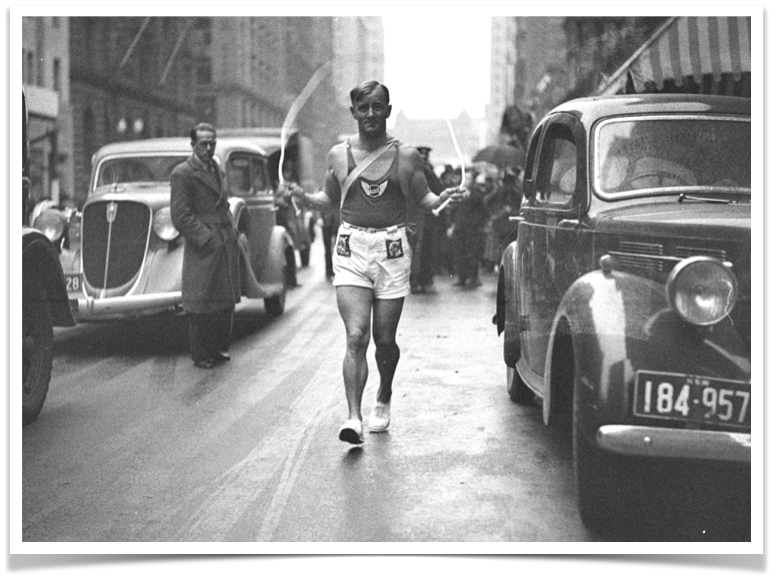
Marburg History
Tom Morris
The man in the photo is Thomas Morris. Tom was one of the most versatile athletic performers in the world. He had established several world records as an endurance swimmer and as a skipper, and also as a crack pedestrian, wrestler, trick and high diver and life-saver.
Tom had just left the Theatre Royal in Sydney (28th June 1937) and was starting out on his quest to skip 701 miles to the Tivoli Theatre in Brisbane. The purpose of this trip was to see southern Queensland, to establish a record between Sydney and Brisbane, and to demonstrate the value of skipping as a means to health.
The Greater Union Theatres sponsored Tom in return for some media exposure.
You can see in the photo that he used ordinary window cord as his skipping rope and had several spares in hand for his journey. He wore rubber soled sand shoes, and was presented with three pairs by the Dunlop Rubber Company.
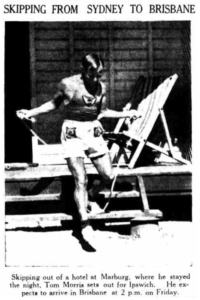 On Tuesday 3rd August 1937, Tom Morris skipped into Marburg and was warmly received by the residents. He had left Gatton at 10a.m. that morning.
On Tuesday 3rd August 1937, Tom Morris skipped into Marburg and was warmly received by the residents. He had left Gatton at 10a.m. that morning.
Tom stayed the night at the Marburg Hotel and skipped his way out at 1 o’clock the next afternoon heading for Ipswich. It was estimated that he would reach Brassall at about 3 o’clock and pass the North Ipswich School about 3.30p.m.
Tom arrived in Ipswich centre at 3.45 p.m., having completed the 12½ miles in two and three-quarter hours. His arrival in the city marked the completion of 676 of his 701 miles journey which, in actual skipping time, was 158 hours.
He appeared on the stage of the Wintergarden Theatre that night and spoke about his travels and advocated physical culture for young folk as a means of ensuring perfect health in later years.
On his long skip, he had worn out three pairs of sand shoes, many pairs of socks, and six ropes.
The method he employed in his skipping was a combination of a slow twirl of the rope and the loping gait of a distance runner. Between each turn of the rope he took two or three short steps, but the whole operation had a rhythm about it that revealed an acquired art.
He travelled in all weather conditions and on one occasion the rain was so heavy that he had to shelter in a hollow log for several hours. “I wish I could have brought some of that rain here,” he jokingly remarked.
He estimated that he averaged about 900 turns of the rope to the mile, so that up to then he had twirled the rope over 608,000 times. His fastest skip was between Maitland and Cessnock, New South Wales, where he covered 81 miles at an average of 10 miles an hour. The worst section of the route was 80 miles of very rough road between Tenterfield and Warwick, which he completed in 18 hours. The continual pounding of his feet on the bitumen roads made his feet sore, but he was so well conditioned that he didn’t notice it until the end of the day’s skipping.
Tom had many experiences along the way, both humorous and interesting, and had a wealth of amusing anecdotes to tell about them. From Sydney to Singleton he had a companion who rode a bicycle with him, but he companion lost his enthusiasm and did not continue.
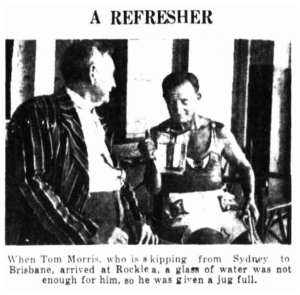 Tom Morris left Ipswich at 1 o’clock on the 5th and arrived at Rocklea that afternoon. The next morning he reached Oxley around 11 a.m. where he stopped at the 4BC transmitting station and said a few words about his journey. He skipped through South Brisbane to Victoria Bridge, through Queen Street and Albert Street, and then round the traffic lights to the Tivoli Theatre, arriving at 2 o’clock. Tom was met at the steps by committee of sportsmen and congratulated by Alderman Arthur Laurie and Ted Lane, the manager of theatre.
Tom Morris left Ipswich at 1 o’clock on the 5th and arrived at Rocklea that afternoon. The next morning he reached Oxley around 11 a.m. where he stopped at the 4BC transmitting station and said a few words about his journey. He skipped through South Brisbane to Victoria Bridge, through Queen Street and Albert Street, and then round the traffic lights to the Tivoli Theatre, arriving at 2 o’clock. Tom was met at the steps by committee of sportsmen and congratulated by Alderman Arthur Laurie and Ted Lane, the manager of theatre.
His arrival was announced on 4BC, and a third broadcast (when Tom spoke about his travels), was made from the 4BC studio at 6.05 p.m. the next night. He appeared on stage at the Tivoli Theatre for a week.
Tom was born in Parramatta in 1893 and lived in Albert Street with his parents. He worked as a carpenters’ assistant on the trams and as a gas light attendant in his youth. He wanted to join the NSW Flying Corps and enlist for service in the Great War but was denied because he was an only child.
Though he was below the average height, his build was of a typical endurance athlete, well proportioned with well developed and flexible leg, arm, and shoulder muscles. He weighed a few pounds over 9 stone and stood 5ft 5½ in his stockinged feet.
Tom already held several skipping and swimming records including skipping from Melbourne to Adelaide and back in 44 days and from Melbourne to Sydney in 28 days. In 1933 he set the world’s endurance skipping record of 18,463 (without a break) in 101minutes. With his hands and feet tied, he set endurance swimming records, and, with a similar handicap, he towed a boat containing three passengers three miles in two hours seven minutes on Lake Burrumbeet, Victoria, in 1936. Tom had saved 18 people from drowning on different occasions, and held the Royal Life Saving Bronze Medallion and Bronze Bar, the R.L.S. Australian Bronze Cross, and the Award of Merit and Merit Bar.
One of Morris’s most amazing accomplishments was his ability to jump from bridges and other elevated places with his feet and hands tied securely, and then swim long distances both under water and on the surface. He has established a world’s record by swimming for 3hr. 45min. with his four limbs bound.
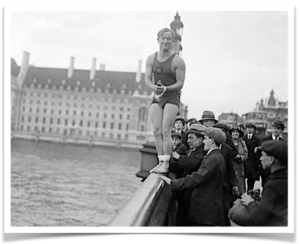
On 1st July 1922, with his hand and feet tied, he jumped from the Westminster Bridge in London and swam to Cleopatra’s Needle.
Tom came back to Ipswich in 1939, and on 5th April broke the world record of 4 hours 9 minutes (set by himself at Toowoomba in November 1938) by staying in the Ipswich City Baths and continually swimming with his hands and feet tied for 4 hours 15 minutes. He was securely tied in a sack, taken to the top of the tower and thrown into the water. He had to release himself in the water and bring the bag to the surface before continuing his swim.
Continuous entertainment (from a stage erected in the baths) entertained spectators during his swim. Gerry Connolly (4BC) led a radio presentation. Others on the bill were Norma Coles, singing star of the Pals Club; Ossie Mezzy, well-known piano accordionist; Doug. Wiedoft, who played saxophones expertly; Eric Roberts, a balladist with an entirely new instrumental act and the Two Venetians. Alan Westbury, who was to fight Hockey Bennell for the welterweight championship on the following night, appeared accompanied by his mentor, Tom Maguire. Tickets sold rapidly at Young’s Newsagency, Brisbane-street, and the prices were Adults 1/ children 6d. Mr. W. Pratt acted as official timekeeper for Morris’s swim.
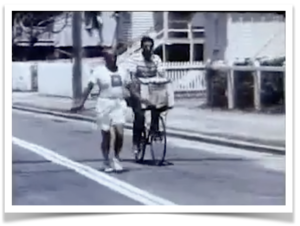
In 1963, aged 70, Tom Morris skipped from Brisbane to Cairns in 94 days, accompanied by his nephew riding a bicycle, with his cat in a basket on the handlebars. He skipped a total of 1,264 miles (2034.211 kilometres) setting a record for the longest distance travelled rope skipping. Tom died in 1967.
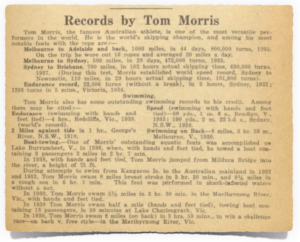
© Jane Schy, 2024
